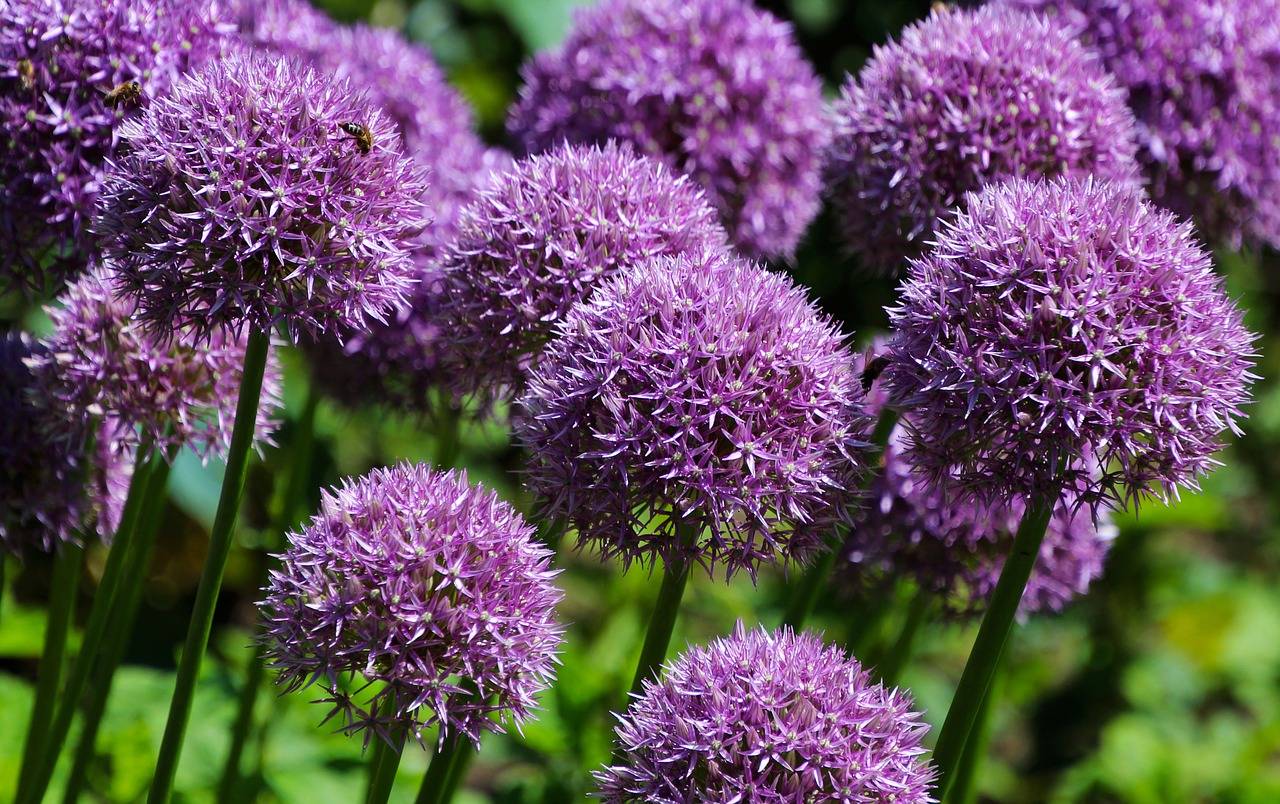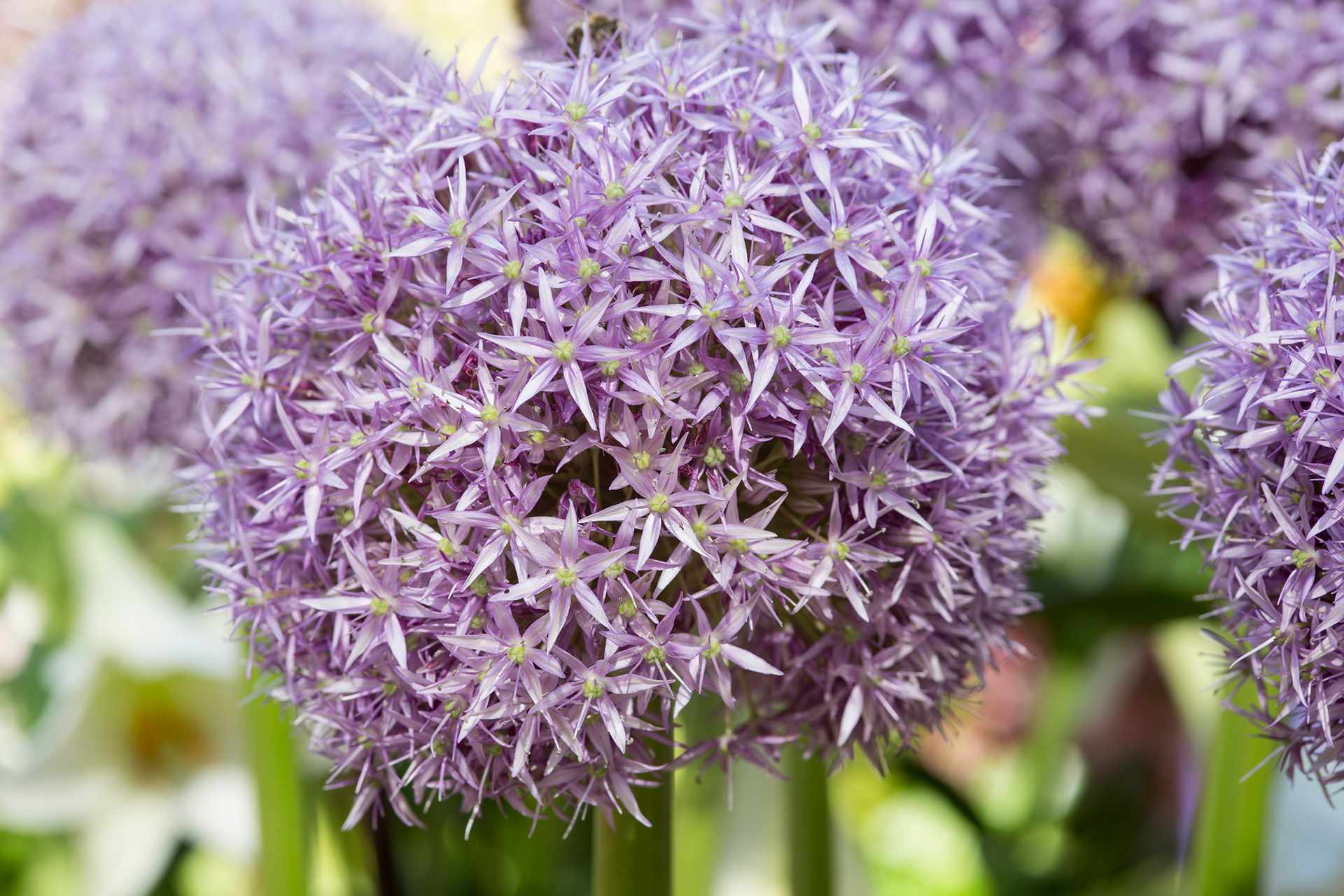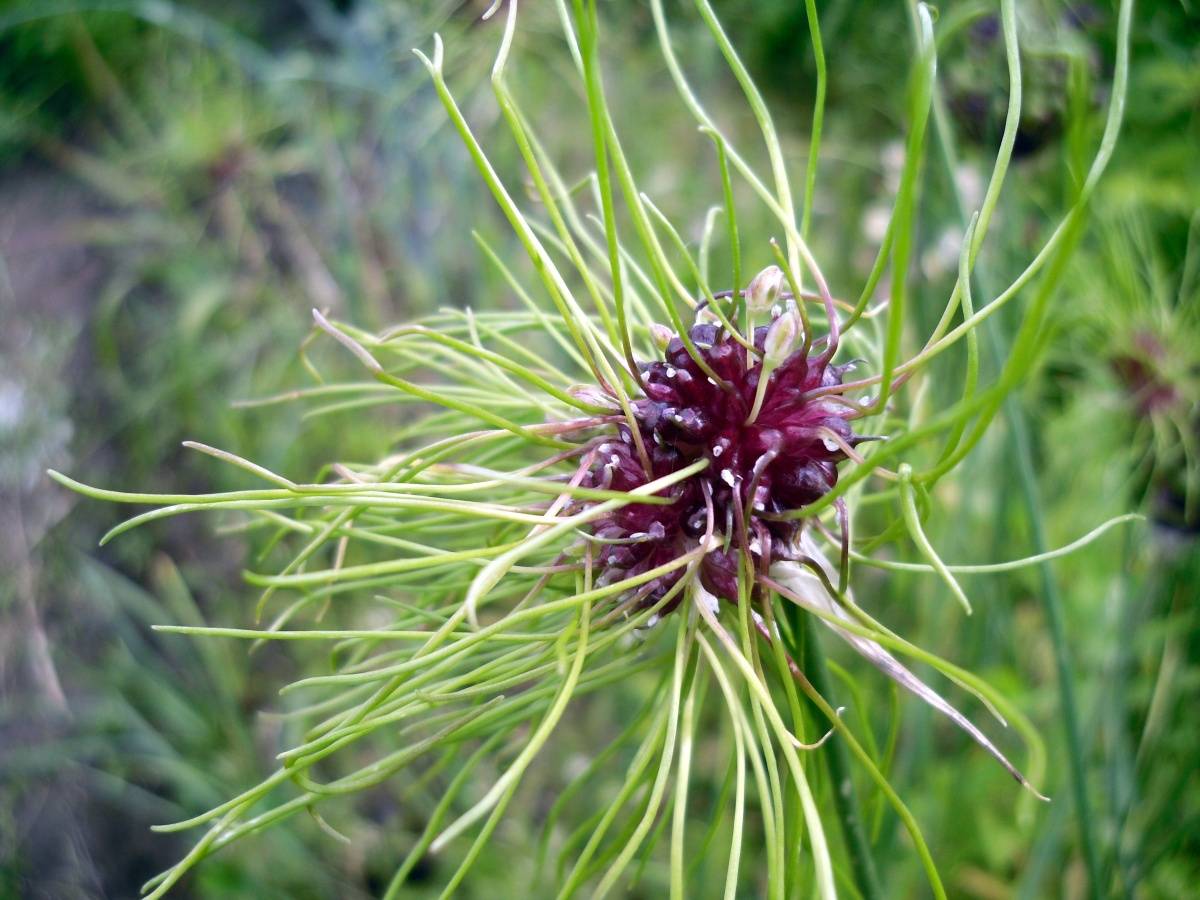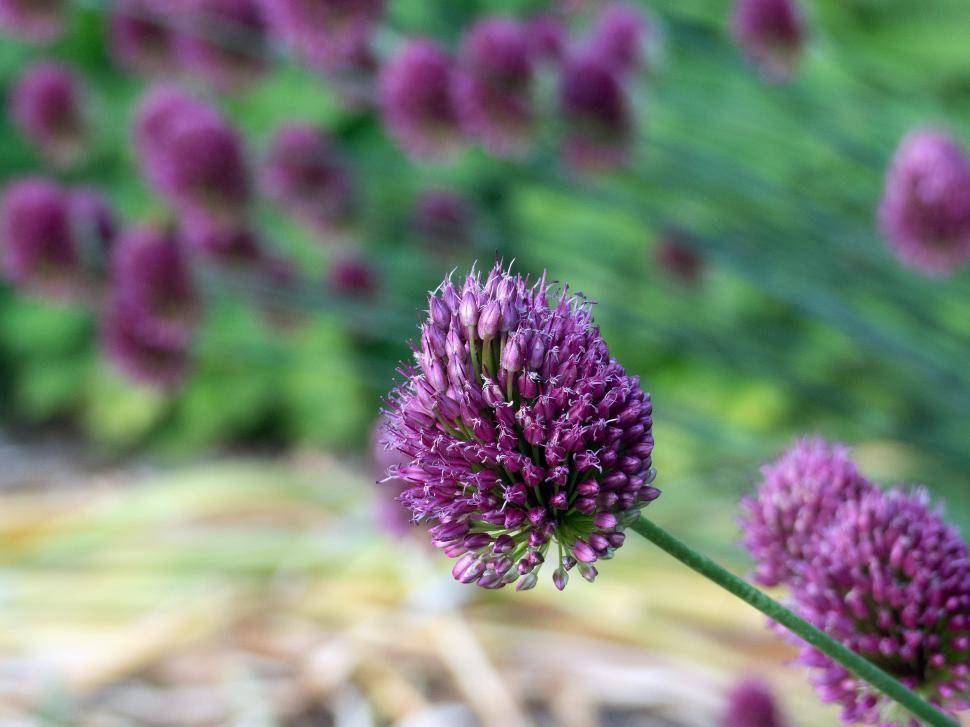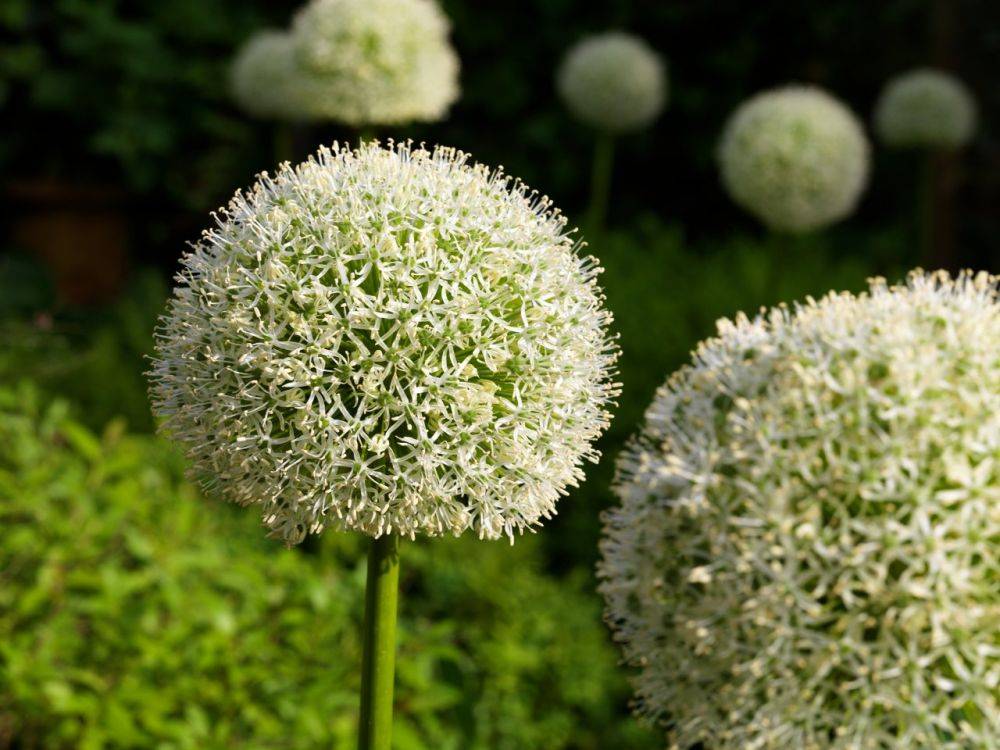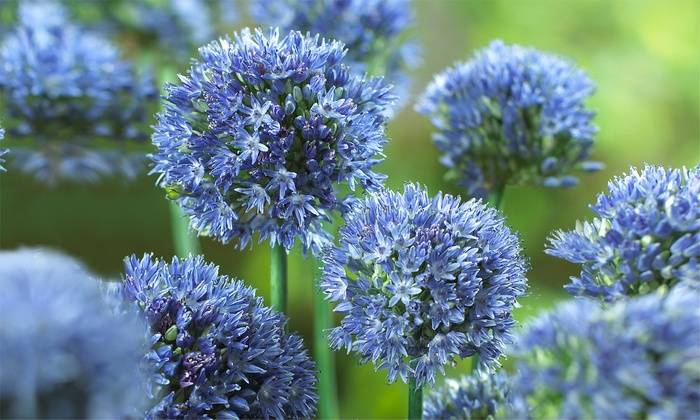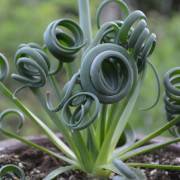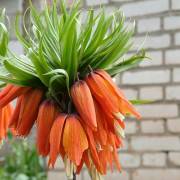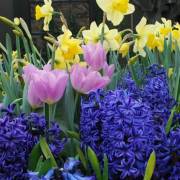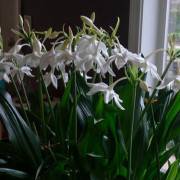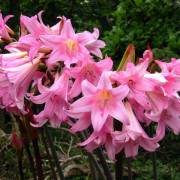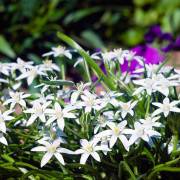Allium bow
Content:
A relative of common onions and garlic, the decorative flowering allium attracts always admiring and amazed glances. It's hard to believe that arrows with colorful caps at the ends can grow so huge.
Allium - decorative onion: popular types and varieties
The name of the species was given by K. Liney. Translated from the Celtic "all" means "burning". Allium (Allium) belongs to the perennial herbaceous plants of the Alliaceae subfamily of the Amaryllidaceae family.
The beauty of this type of onion is given by flowers, collected in spherical inflorescences, reaching a diameter of 30 cm. A small amount of long and narrow succulent leaves forms a rosette at the very bottom. A thick, glabrous, smooth stem holds the weight of the inflorescence.
 Allium border - an unusual and very effective solution for the garden
Allium border - an unusual and very effective solution for the garden
Decorative bulgarian onion
The exact name is Allium Nectaroscordum siculum subsp. Bulgaricum. It indicates that the leaves smell like garlic when touched. This plant is native to Sicily. Hence, there are many of its popular names: Sicilian onion, Italian garlic, honey garlic.
In the spring, when the Bulgarian Allium wakes up, the first to appear are the thin long stems stretching upward. At their ends are tips formed from green leaves twisted into a spiral, thinner than paper. At this point, the tips are shaped like chili peppers. Gradually, this roll opens and 20-30 buds on thin legs open up. The umbrella as a whole is about the size of a tennis ball. From the buds, bells of burgundy or pink color with a snow-white border bloom.
The height of the stems is up to 120 cm. It blooms from May to July. Propagated by bulbs and seeds, and sometimes by self-sowing. The bulbs are planted in the fall, covering well, since the allium dies in severe frosts. Hence, in many regions, only spring planting is practiced, and in winter the bulbs are stored in a cool place.
Allium Gladiator
This variety is one of the largest among the popular garden alliums. The height of the arrows, depending on the growing conditions, reaches 1 m and even more. Flowers with six petals form purple globular inflorescences (up to 20 cm across). Flowers have a special decorative effect, they are quite large and look like six-rayed stars. Fully blossoming inflorescence looks like a purple shaggy ball.
The plant is quite edible, and in many European countries it is specially planted in the beds along with other vegetables. Surprisingly, they eat not powerful and juicy peduncles, but belt-shaped leaves located at the very bottom. They grow from 6 to 8. Such a leaf is up to 70 cm long and up to 10-12 cm wide. According to the experience of gardeners in Russia, the plant hibernates with a small shelter in the open ground of the Moscow region and the Leningrad region.
Globemaster Ornamental Bow
Large-flowered allium, blooming in May with delicate lilac flowers, collected in a large (up to 15 cm in diameter) ball. It differs from other decorative bows in that flowering lasts until September.Prefers loose soil with a small amount of organic matter.
Allium globermaster
Globemaster's bulb is split in half during the summer. The inflorescence of viable seeds almost never gives. In September, the bulbs are dug up every 2-3 years to dry for 2 weeks, carefully divide and immediately plant in a new place. Can hibernate without additional shelters. Dry inflorescences can be used for winter bouquets.
Allium Purple Sensation
The name of the variety is given for its dense umbrellas (up to 12 cm in diameter) with numerous flowers of a rich purple hue. This type of allium is valuable for flower gardens because it tolerates shade well and can winter without additional shelter. It is planted as backdrops, shaded by tall bushes. The height of the stems reaches 1.5 m with a minimum height of 1.2 m.
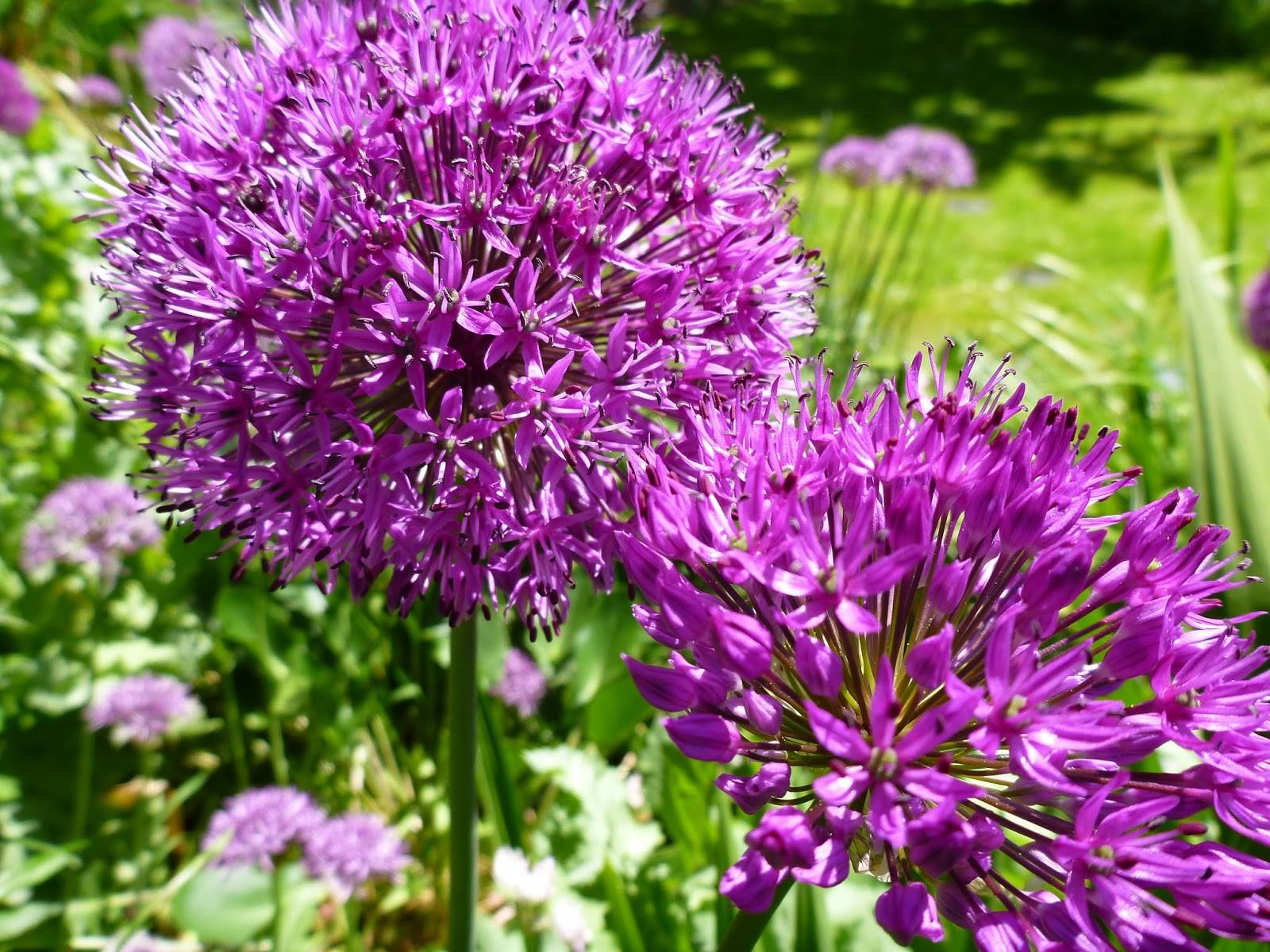 Decorative bow Pearl Senseishen
Decorative bow Pearl Senseishen
Flowering begins in May and lasts about 30 days. Large bulbs are planted sparsely, no more than 4 pieces. per 1 m², therefore, to cover the bare soil between the plants, ground cover plants with a shallow root system are planted nearby: sedums, sedum, purslane.
Allium Hair
It is called round-headed, drumsticks, spherocephalum. Allium hair is native to southern Europe, found in northern Africa and western Asia. The ancestor is the onion-batun. The umbrella peduncle has a non-standard oval shape. Peduncles stretch up to 40 cm, and in the lower part they are thickened and painted pinkish-white, darkening by summer. As they bloom, the flowers grow overgrown with long green petals that look like thick hairs. The total size of the inflorescence is about 4 cm across. Flowering begins in early May and lasts until July.
The total plant height can reach 80 cm. Prefers sunny areas and fertile soil with good water permeability. It tolerates partial shade well. After drying, the inflorescences stand well in winter bouquets.
Schubert's allium (Allium schubertii) is just as exotic. Its height is only 30 cm, and the diameter of the inflorescence in the form of a spherical star is up to 30 cm. All pedicels of this interesting plant are of different lengths, which gives the umbrella an enchanting appearance.
Allium Sphaerocephalon
The round-headed allium is found on almost all continents. It grows on rocks, dunes, meadows and forest clearings. The perennial is known in cultivated gardening since 1783. The height of the shoots reaches 50-150 cm. The inflorescences are in the form of a ball about 3-4 cm in diameter. The color is from pink to violet-red. Perfect for cutting and drying.
Flowering lasts from May until the end of summer, when the dormant period begins. In late autumn, the growth of a bulb about 2 cm in diameter resumes again, so this species is planted only in September. Prefers sunny places with clay or sandy-clay soil. Differs in high frost resistance practically throughout the entire territory of Russia and does not require winter shelters. The transplant is carried out every 2-3 years, after which young bulbs in the first year may not produce inflorescences. A similar variety is allium Millennium, but shorter, up to 40 cm.
Allium White Cloud
The Dutch White Cloud hybrid allium grows up to 1 m in height. A distinctive feature is the lush white umbrella inflorescences that bloom from May to June. Prefers sunny areas, and soil with a neutral pH level = 5.5-6.0. According to gardeners, it tolerates partial shade, preserving the rich green of flower stalks and leaves. Watering requires moderate, no flooding.
The variety is bred on the basis of the so-called grape onion (Allium ampeloprasum). It is also called field garlic or summer leek. A similar variety with snow-white inflorescences is Allium Mount Everest, as well as Allium neapolitanum with a loose umbrella and a height of only 30 cm. The flowering shoot of the White Clouds variety is formed in the second year of the bulb's life. The transplant is traditionally carried out every 3 years.After drying, young bulbs are immediately planted in a new permanent place, deepening the bulb itself by 3 heights.
Allium Giganteum
It is not by chance that this variety is called gigantic and gigantic. Its peduncles are visible from afar, as they reach up to 150 cm. But some gardeners claim that it can grow up to 2 m in height. Globular inflorescences consist of 2-3 hundreds of tiny purple flowers about 10 cm in diameter. Usually this onion blooms in May and blooms until July for about 20-30 days. At this time, it prefers a temperature of 18-25 ° C.
The variety is obtained from a wild-growing predecessor that is found in the subtropics of Central Asia and Iran. In the wild, it grows in nut and pistachio groves. Very similar to the highest bow. The bulbs are larger than usual, up to 7 cm in diameter, flat-round in shape. Belt-shaped long leaf of gray-green or green color, it is up to 10 cm wide.
A feature of the decorative perennial, inherent in other alliums, is the rather rapid burnout of the root rosette of leaves, which turn yellow and dry out even before the peduncle fully blooms. For this reason, the bottom must be masked with low-growing ornamental plants, for example, you can plant hosts, anemones, petunias, irises nearby.
Planting is carried out in the spring, when the air temperature no longer drops below 5 ° C. The optimal distance between the bulbs is about 25 cm. If the gardener does not want to get daughter bulbs, then allium is planted together with other spring bulbs, for example, tulips. When both flowers have faded, they are dug up and kept in a dry, dark place until September, when it is time for autumn planting.
Allium Moli
In the catalogs of landscape design and in nurseries, the perennial can also be found under a different name - Golden Garlic (Golden garlic). In the wild, it is found everywhere. In Russia and European countries it is widely used as an ornamental plant. Prefers moist limestone soil.
A rosette of flat and long spear-shaped leaves up to 5 cm wide grows from the bulb, which are folded and bent along their central vein. Each flower from a yellow umbellate inflorescence has a diameter of about 1 cm. Unlike other aliums, this type of flowers sit on thin pedicels up to 2 cm in length. The umbrella is very loose, hemispherical. The size of the inflorescence is about 6 cm in diameter. The length of the peduncle is 30 cm. The decorativeness of the plant persists for a long time, even when the flowering ends, and it lasts from mid-June for about 15-25 days.
In the garden, planting is carried out by children and much less often by large adult bulbs. For several years, the baby grows to its final size, giving along the way many daughter bulbs. Reproduction in the future (after 4-5 years) is not difficult. This species is very rarely propagated by seeds, since many difficulties arise with this. First of all, the survival rate of seedlings is very low, and the flowering of the surviving plants will occur only 2-3 years later, when the bulbs have gained sufficient mass.
Can be planted in spring as well as late August. The last date for autumn planting is September 10. It's all about the root system of the bulbs, which wakes up with the arrival of coolness and begins to grow.
Blue bow
It is often called royal. Globular bulbs up to 3 cm in diameter give a rosette of light green grooved leaves up to 25 cm long and 1 cm wide. Young leaves are cut off for eating.In mid-June, the foliage turns yellow, and then the peduncle grows up to 80 cm tall. The spherical cornflower-blue inflorescence has a diameter of about 8 cm. Each bell-shaped flower 1 cm long does not open immediately, but gradually. This time lasts about 1.5 months. Gradually, the blue color turns into a rich lilac, and when it dries, it turns into silver.
According to the description, the species is characterized by the formation of many seeds ripening by mid-August. The plant reproduces easily by self-seeding. In autumn, each of the bulbs produces many tiny babies that grow around the bottom (up to 70 pieces).
Is it possible to eat decorative allium bow
Mostly all types of decorative perennials are used as decorations in gardens and flower beds. You can eat them, but they rarely do it, with the exception of the allium Gladiator, which is specially planted as a garden plant. The thing is that the price of the bulbs is high, the size is small, and an adult can eat only up to 3 g per day without negative health effects.
The leaves of many types of allium have a pleasant garlic taste and are considered healthy. But you can cut them off only until the inflorescence is formed, because at this time it is extremely important for the plant to get the maximum of nutrients. Onions usually taste like radishes or radishes. They are eaten boiled and baked, pre-soaked in water to remove the bitterness. Only the master will cope Too much allium in the diet can lead to an allergic reaction.
About flower beds, where decorative bows are present in the composition, the general opinion agrees: it is very effective. The inflorescences are unlike any others, which is why they are so popular. They make a great contrast with other colors, shading them advantageously. Leaving is relatively simple, which means that even a beginner can handle it.
Video

